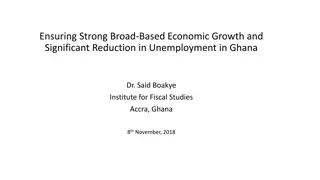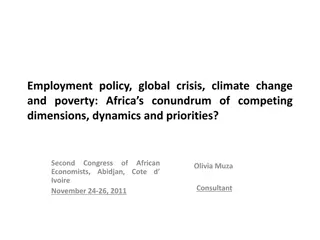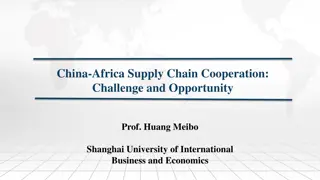Unemployment Figures in Africa: Causes, Solutions, and Impact
Explore the concerning issue of unemployment in Africa, analyzing figures, causes, and solutions. Learn about the challenges faced, particularly by the youth, and the implications for sustainable economic growth.
Download Presentation

Please find below an Image/Link to download the presentation.
The content on the website is provided AS IS for your information and personal use only. It may not be sold, licensed, or shared on other websites without obtaining consent from the author.If you encounter any issues during the download, it is possible that the publisher has removed the file from their server.
You are allowed to download the files provided on this website for personal or commercial use, subject to the condition that they are used lawfully. All files are the property of their respective owners.
The content on the website is provided AS IS for your information and personal use only. It may not be sold, licensed, or shared on other websites without obtaining consent from the author.
E N D
Presentation Transcript
The Unemployment Factor Africa Union Commission Economic Affairs November 23, 2011 By: Lulit Bereda
Outline Unemployment Figures in Africa Causes of Unemployment Solutions to the Unemployment problem Unemployment and sustainable Economic Growth Conclusion
Unemployment Figures in Africa Africa achieved relatively high growth rates in the first decade of the 21stcentury, culminating in a continent-wide average growth rate of 6.1 per cent in 2007 (Economic report of Africa , 2010) The rapid growth resulted from increased investment foreign direct investment (FDI) inflows of other foreign resources macroeconomic stability and better economic management
Unemployment Figures In 2009, the youth unemployment rate in North Africa amounted to 23.7% . In sub- Saharan Africa, 60% of the unemployed are youth, and an average of 72% of youth live on less than US$2 a day. Since the onset of the economic crisis, between 2007 and 2009, youth unemployment increased by 7.8 million at the global level (1.2 million in 2007/08 and 6.6 million in 2008/09).
Unemployment Figures in North Africa (2008)
Unemployment Figures in West Africa Total Pop in Millions % of youth (0-14) % of youth (15-24) % of youth (25-29) Unemployed youth Country Cote d'Ivore 18.2 45.10% 22% 7.60% 31% Liberia 3.3 44.80% 19.70% 7.50% 88% Sierra leone 5.5 43.40% 18.80% 7.30% 60% Source: United Nations Office in West Africa (2007)
Unemployment Figures in East Africa (Ethiopia) Source : Central Statistics Agency
Causes of Unemployment 1. Demographic challenges 2. Enrollment rates and quality of education 3. Health Status 4. The Global Financial crisis 5. Migration Patterns
Causes 1. Demographic challenges One of the major causes of unemployment is the exponential growth rate of the population, especially the youth. Africa has the fastest- growing and most youthful population in the world. Youth make-up as much as 36 % of the total working-age population and 3 in 5 of Africa youth are unemployed . (ILO)
Causes 2. Enrollment rates and quality of education Lower enrollment rates, coupled with low completion rates, low quality of education and a failure to orient curricula with the needs of the private sector have contributed to the mismatch of skills of youth labor markets in Africa (UNECA) Youth literacy in Sub-Saharan Africa is 76.8 %, (UNDP 2004)
Causes 3. Health Status One of the major problems facing Africans is lack of health and medical services limiting the percentage of population that would otherwise be employed. At 45.2 years, life expectancy in Sub-Saharan Africa is among the lowest in the world. On top of this problem, Sub-Saharan Africa has the highest share of young people living with HIV: nearly two- thirds reside in the region.
Causes of Unemployment Estimated HIV infection rate in Africa in 2007
Causes 4. The Global Financial crisis The current global crisis has exacerbated the unemployment rates in Africa. Foreign Direct Investment (FDI) in Africa has drop by roughly 26.7% in 2009, compared to 2008. (IMF) According to the African Development Bank, the GDP growth of African States fell from an average of 5.6% during 2001 08 to 2.5% in 2009.
Causes 5. Migration Patterns Mass migration of young people from rural areas to urban cities contributes to the rising unemployment rate. Empirical analyses show that rural youth migrate to urban areas to find better educational and work opportunities and a way out of poverty. Yet, despite the earned income, the mass migration of youths to urban areas does not mean that all will find employment
Solutions to the Unemployment problem 1. Education and training 2. Effective agricultural policies 3. Private Sector involvement 4. Public Works programs 5. Employment subsidies 6. Promoting self-employment and entrepreneurship
Solutions to the Unemployment problem Employment subsidies The objective of a targeted subsidy is to improve the employment prospects and opportunities for a particular group by reducing the costs of employing the targeted group relative to other groups, making them more attractive for firms to hire them.
Solutions Youth employment subsidy programs also lower the relative cost of hiring a young person (while leaving the wage the employee receives unaffected) and therefore increases demand for young workers.
Solutions Education and training The low level of education of young people is the significant factor that causes the rising unemployment rates, there should be improvements to the education and training provided to young people, with a greater focus on vocational skills.
Solutions Educational subsidy programs should also be implemented in order to increase the enrollment rates of the rural and urban youth population.
Solutions Effective agricultural policies One of the main focuses of African governments should be on effective agricultural policies to prevent the ongoing migration from rural areas to urban centers, which is a major factor in the rapid growth of unemployment
Solutions it is necessary to create jobs that will increase rural income and welfare and, thereby, retain young people. Their needs to be an increase in investments in irrigation, water resources management, research and extension, rural public services, use of improved seeds, fertilizers and better agricultural practices.
Solutions Private Sector involvement Public-private partnerships are essential for overcoming supply constraints in education A linkage between the formal education sector and the private sector will ensure that curricula are demand-driven, helping to improve the skill match between school leavers and the demands of employers.
Solutions Public Works programs Are a broad category of projects, financed and constructed by the government, for recreational, employment, and health and safety uses in the greater community. Public works programs can be useful for revamping the economic indicators and establishing growth and development.
Solutions For E.g. , the Senegalese government, set up a US$33 million public works program that targeted the growing number of unemployed youth. During the first phase of the program around 80,000 jobs were created for young people in 416 projects in small-scale enterprises. Source : UNECA
Solutions Promoting self-employment and entrepreneurship Self-employment could be an important generator of jobs and ultimately economic growth. Even though young people lack the experience and skills to become entrepreneurs, they are also capable of developing innovative and creative ideas.
Solutions young people can be given help with training, mentor support, support with developing networks and access to credit and office facilities
Unemployment and sustainable Economic Growth Long term strategies need to be implemented in order to solve the unemployment problem. Investment that will transform the structure of African economies from reliance on low- employment-generating natural resource extraction to high-employment labor-intensive manufacturing, agro-industry and service provision.
Unemployment and sustainable Economic Growth Factor markets will have need to be reformed to encourage the use of labor-intensive production techniques, in contrast to current policies, which favor capital-intensive techniques
Conclusion There are no easy solutions to the problem of rising unemployment rates in Africa In order to bring about change and find a solution, the States of the continent need to unite and include employment as a part of the growth strategy for every African country.
The End African Union Commission November 23, 2011























